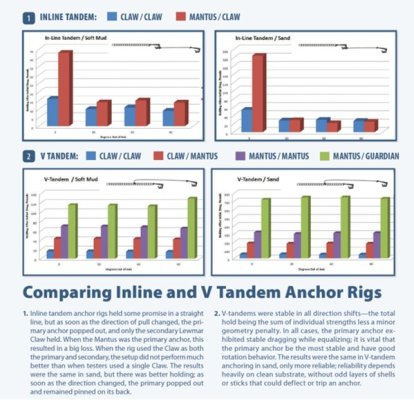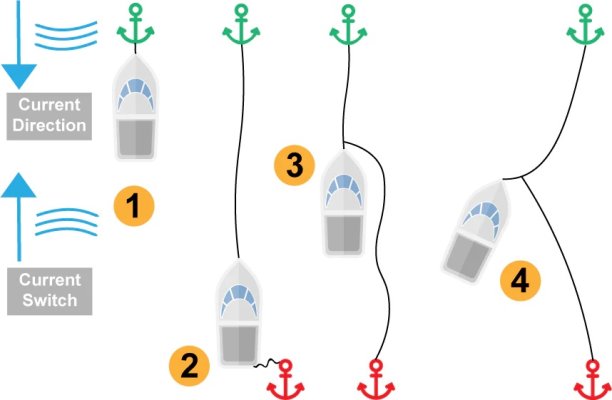I have only ONE story to tell to add to this discussion...
There are lots of really good points in this thread and I cannot disagree with any of them!
The first thing we did when we bought our MS 390 a few years ago, (which came with a plow and 50 ft of 3/8" chain + nylon) was to get a larger anchor (Rockna Vulcan 25 - 55#) and 200 ft of 3/8" chain + nylon + snubber ... so we really do not deploy a second anchor very often at all.
There was [only] ONE night just over a year ago, when a second anchor was deployed due to the forecasts and the mix conditions we were in. The old plow and its 50ft of 3/8" chain was deployed in a "V" configuration with the newer main anchor and rode. Everything held fine to our satisfaction.
The unanticipated problem came in the morning when it was time for me to retrieve the 50 feet of 3/8" chain for the second anchor... without the help of a windlass. That was neither fun, healthy for my back, nor fast 'n' easy.
To complicate matters, we had a lock opening we were trying to time, and we had to radio the lock master to let him know we'd need another 20-25 minutes... and that he didn't have to wait if it wasn't prudent to do so with other boats arriving into the chamber.
He waited... but the "pressure" was on me to get 50 feet of 3/8" chain up on the deck in a hurry was NOT FUN. That, of course, was followed by our more familiar weighing of the main anchor and rode.
SO,
Without a second windlass, I think there is a practical argument for having a more modest length or size of chain on the second anchor (unless you have a second windlass!)
We
gotta have a spare / second anchor as there are countless reasons and examples of why I wouldn't be comfortable without a second one (even if it is
rarely deployed).
Today, I now have about 15 feet of 3/8" chain + nylon attached to that plow as our second anchor. I don't think my admiral could heft it all up, but with me at the helm I could position the boat so she can get a lot of that nylon scope up and tied. Then, I'd leave the helm to finish the job... (all while our main anchor was still in-place.)
Untangling the two would obviously have further complicated if it was necessary!
Having a main anchor and rode sized for 99.9% of all situations (including wind + current + bottom conditions) is well worth the investment. "I don't think I've ever seen a boat with an anchor too big for it."
related pics:
https://shellerina.com/2020/09/18/shelly-inspects-her-new-anchor/
https://shellerina.com/2020/09/19/new-ground-tackle-system-is-deployed/
https://shellerina.com/2020/09/21/splicing-8-plait/




